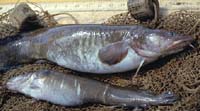![]()

Burbot
Common name(s): Burbot, Lawyer, American burbot, ling, eelpout, loche, freshwater cod Scientific name: Lota lota Description:
*NOTE: Although the average size is about 2 lbs., specimens weighing 71 lbs have been taken from European waters. It is thought to be extinct in Britain. Spawning: Burbot spawn under the midwinter ice, usually in one to four feet of water, though sometimes deeper. By midsummer, they move out to the cool depths of the lake, where they roam the open waters with lake trout, lake whitefish and other deepwater fish. Angling: These elongated, cylindrical, fish is the only member of the codfish family that lives exclusively in fresh water. It is widely distributed in the deep, cold waters in the northern latitudes. Burbot inhabit most waters of Alaska, Canada and the northern United States as well as corresponding latitudes of Eurasia. Despite the burbot's homely form, its meat is palatable and nutritious. A delicacy in Scandinavia, the burbot's liver contains oil said to rival that of the saltwater cod. In the U.S., burbots -- commonly called "lawyers" in the Great Lakes region -- have long been overlooked as a food fish. Early Great Lakes fishermen derided them as trash fish. In the middle of the 20th century, the lakes' burbot populations declined under the onslaught of the sea lamprey. Today, however, burbot are returning to the lakes in increasing numbers.
Many knowledgeable fishermen savor burbot. When boiled and buttered, the sweet flavor of burbot has earned it the title of "poor man's lobster." Though they continue to have an undeserved reputation as "trash fish," the commercial harvest of burbot from Green Bay and northern Lake Michigan increased nearly fivefold during the early 1980s to a total of nearly 100,000 pounds annually. |
